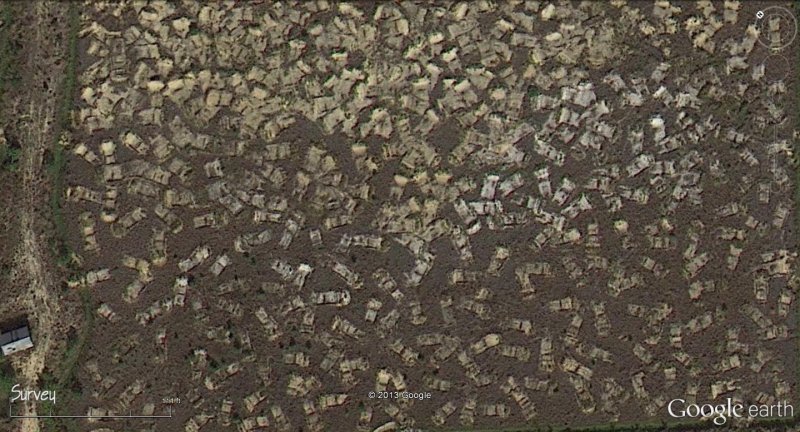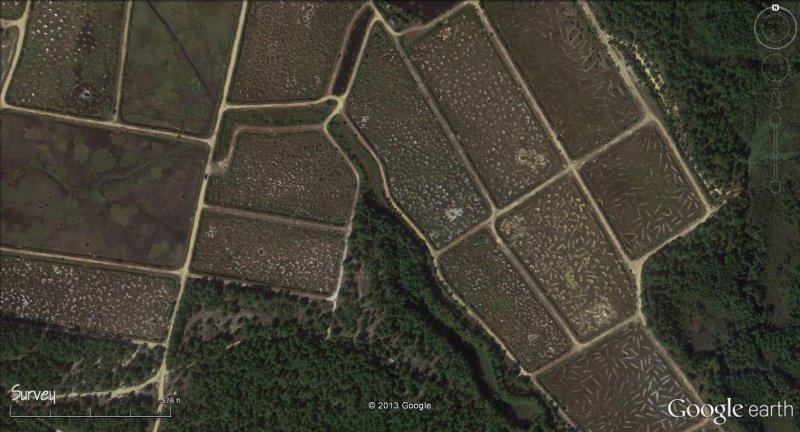Parker Southgate Yellow Trail closed
- Thread starter ecampbell
- Start date
You are using an out of date browser. It may not display this or other websites correctly.
You should upgrade or use an alternative browser.
You should upgrade or use an alternative browser.
Hasn't this been closed for a year or so? I think some of the dikes may have been damaged during the heavy rain from Sandy.
Actually, when you think about it, the NJCF destroyed more dikes than Sandy ever did.
Tony DeMarco is probably tossin' and turnin' in the great beyond.

Hey 46er, where did you get that photo?
Google Earth. There are several locations in that area that look/looked like this.
I have always wondered why the retired bogs were dug out in that fashion. Does anyone know the reason for the many excavated holes?
Are they holes or loads of dumped stuff? Hard to tell, but there sure are a lot of them. Maybe its something like crop circles; these are bog cubes.


Are they holes or loads of dumped stuff?
They are holes made by a backhoe or cat. They aren't very deep though.
After the property was acquired by the NJCF and the State, a plan was developed to try to restore much of the bog areas to wetlands more representative of the Pines.
Atlantic White Cedar - Chamaecyparis thyoides - were planted and protected with a deer fence.
Ducks Unlimited played a major role on the modification of existing water management systems; overflow concrete spillways were installed that could be driven over.
An application was made, and approved, for Fed funding to try to convert the sterile sand bogs to a condition conducive to native growth. The divots were dug down to the water table, and the excavated soil dumped alongside. Amazingly, seeds that had been buried for several decades sprouted, and the landscape began to look more like natural wetland.
The beavers have had a field day; unfortunately they tend to block the water routes and mess up the planned water flow.
Several of us are monitoring, virtually year around, 5,000 square foot sites (some marked with little orange flags) all over the preserve, recording each different plant species, when it emerges, flowers, fruits, making specimens for the herbariums at the Academy of Natural Sciences in Philly and Rutgers, photographing the site to show overall changes. We're in the 2d year of doing so. Species diversity is amazing when you really get serious about looking and doing so on a regular, short interval basis. To someone learning botany as we go, it's been a fantastic opportunity. Not to mention meeting and talking with grad students doing studies on snakes, mammals on the preserve. Incidentally, one said she thinks Parker is the East Coast heaven for moles - more per given area than any other place known.
All the above is what I've learned and is subject to correction by NJCF people (invitation to do so!)
There are also several biological study projects by Drexel U. students down on the military's Warren Grove Gunnery Range.
Atlantic White Cedar - Chamaecyparis thyoides - were planted and protected with a deer fence.
Ducks Unlimited played a major role on the modification of existing water management systems; overflow concrete spillways were installed that could be driven over.
An application was made, and approved, for Fed funding to try to convert the sterile sand bogs to a condition conducive to native growth. The divots were dug down to the water table, and the excavated soil dumped alongside. Amazingly, seeds that had been buried for several decades sprouted, and the landscape began to look more like natural wetland.
The beavers have had a field day; unfortunately they tend to block the water routes and mess up the planned water flow.
Several of us are monitoring, virtually year around, 5,000 square foot sites (some marked with little orange flags) all over the preserve, recording each different plant species, when it emerges, flowers, fruits, making specimens for the herbariums at the Academy of Natural Sciences in Philly and Rutgers, photographing the site to show overall changes. We're in the 2d year of doing so. Species diversity is amazing when you really get serious about looking and doing so on a regular, short interval basis. To someone learning botany as we go, it's been a fantastic opportunity. Not to mention meeting and talking with grad students doing studies on snakes, mammals on the preserve. Incidentally, one said she thinks Parker is the East Coast heaven for moles - more per given area than any other place known.
All the above is what I've learned and is subject to correction by NJCF people (invitation to do so!)
There are also several biological study projects by Drexel U. students down on the military's Warren Grove Gunnery Range.
After the property was acquired by the NJCF and the State, a plan was developed to try to restore much of the bog areas to wetlands more representative of the Pines....
That is all very nice, but it kind of flys in the face of what the previous owners wishes were. Restore and preserve are exact opposites.
"In their twilight years, J. Garfield and his beloved sister, Anna Lynne DeMarco Papinchak, decided that this paradise which they owned and for which they had deep respect and reverence should be forever preserved."
The records of the several botanical test sites include GPS location, description of the site, plants found and populations, pictures, etc. It'll be very interesting to see the changes over the years. The test sites include areas around the armored spillways (at least 3 this year in different parts of Parker), along the Wading River, a borrow pit (we did that one last year and this - BIG differences due to rainfall) - open bog area, etc., in portions of Parker east and west of 563. Soil tests were made at several sites.
I seen no such signs out there yesterday.matter of fact I walked the trail completely around the bogs till just before closing the loop.There were no signs at the fork in the road.If I had of walked counterclockwise I could have saved us a lot of trouble.


